The Ten Bulls (or Ox-herding Pictures) of Zen
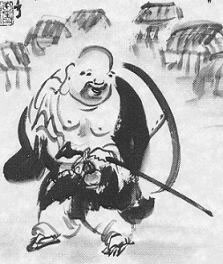
The ‘Ten Bulls of Zen’ (or alternatively the ‘Ten Ox-herding Pictures of Zen’) is a metaphoric depiction of stages of self-realization, involving an ox-herder (representing the seeker or the separate self) and an ox or bull (representing our true, primordial nature, or the Ground of existence). It remains one of the best models for describing the awakening process. It unfolds in ten stages that define the relationship of our mind to the deepest truth of reality. Initially this deepest truth, symbolized by the bull, appears separate from the seeker, but eventually it 'disappears' (or is forgotten) representing the realization that the separate self (the seeker) has never truly been separate from what it seeks.
The Ten Bulls of Zen was originally a creation of the Taoist tradition in China, but was developed and enhanced by the 12th century C.E.
Chinese Cha’an (Zen) master Kuo-an Shih-yuan (Kakuan Shien), depicted above. The Ten Bulls defines
the stages of awakening as follows, with Kakuan’s commentary in italics (as with many of the old texts there are several different translations into
English; what follows is but one version). My own comments follow each image:
I. The Search for the Bull
In the pasture of this world, I endlessly push aside the tall grasses in
search of the bull. Following unnamed rivers, lost upon the interpenetrating
paths of distant mountains, my strength failing and my vitality exhausted, I
cannot find the bull. I only hear the locusts chirring through the forest at
night.
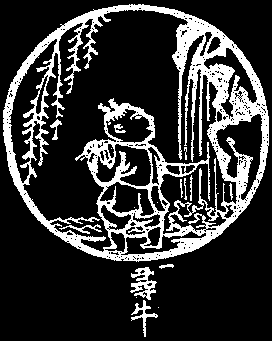
The seeker looks for the bull (symbolic of his or her true nature, the
‘Buddha-mind’). This is the beginning of the path. It is usually heralded by a
fundamental disappointment with one’s life, and a recognition, however dim,
that we have been living a life governed by endless distractions leading us
down endless garden paths of empty conventions, fads, and general nonsense. The search for the real meaning of our
life begins: we are now seeking, however uncertainly, the bull. In the context
of meditation, this can be thought of as marking our initial efforts as we sit.
2.
Discovering the Footprints
Along the riverbank under the trees, I discover footprints! Even under the
fragrant grass I see his prints. Deep in remote mountains they are found. These
traces no more can be hidden than one’s nose, looking heavenward.
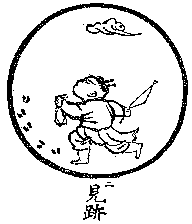
The
footprints of the bull are spotted. This is the point when the seeker’s
confidence in the reality of the bull—in the real possibility of
awakening—begins to grow. It could be said to represent the conviction that the possibility of salvation or liberation from the bondage of
the mind and its powerful delusions is real. In meditation, it marks the
progress that is noted as the mind begins to focus more clearly.
3. First sight of the Bull
I hear the song of the nightingale. The sun is warm, the wind is mild,
willows are green along the shore, here no bull can hide! What artist can draw
that massive head, those majestic horns?
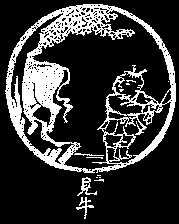
The bull is spotted! The bull appears far away, perhaps even hiding behind a
bush, but now there is no doubt that it is real. Visual confirmation has
happened. This stage marks the first glimpse of the underlying principle of
mysticism, that all that is perceived is ultimately not separate from the mind that perceives it. This can be likened to an initial awakening, usually called satori or kensho in Zen. It is an incomplete realization -- symbolized by the fact that the seeker only sees the bull's hindquarters, not its entirety -- because it is going to require sustained discipline and a great passion for truth in order to deepen this realization and begin to integrate it into one's daily life.
4. Catching the Bull
I seize him with a terrific struggle. His great will and power are
inexhaustible. He charges to the high plateau far above the cloud-mists, or in
an impenetrable ravine he stands.
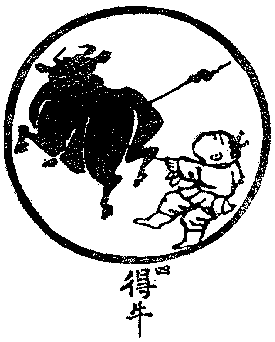
The bull is ‘caught’, but the seeker’s relationship with him is rocky. What
this implies is that even after an initial glimpse into our true nature, unruly
mental states—in particular, strong feelings and emotions—still arise. In many cases, these difficult mind states arise even more strongly after our initial awakening, because the mind is putting up its natural resistance to change. The bull
is ‘wild’. Despite our initial glimpse, we are still very much in the grips of our unconscious mind with its habits and agendas. This is a crucial step, one in which many seekers of truth fail to successfully pass through.
5. Taming the Bull
The whip and rope are necessary, else he might stray off down some dusty
road. Being well trained, he becomes naturally gentle. Then, unfettered, he
obeys his master.

If we successfully negotiate the previous stage -- by applying real discipline and commitment to our path -- we now reap the benefits. The 5th stage refers to the important realization that all thoughts arising in the
mind are manifestation of our true nature. All
is as it is, and must be seen that way (as opposed to being ‘made
wrong’—‘this should not be the way it is’). With this realization, our mind begins to settle and to work with us, rather than against us.
6. Riding the Bull Home
Mounting the bull, slowly I return homeward. The voice of my flute intones
through the evening. Measuring with hand-beats the pulsating harmony, I direct
the endless rhythm. Whoever hears this melody will join me.

The
sixth stage represents a deepening of understanding, and the corresponding tendency to disengage from exhausting mental struggle. Krishna, in the Bhagavad
Gita [14:24-25] makes reference to this state when he remarks to Arjuna,
‘Who dwells in his inner self, and is the same in pleasure and pain; to whom
gold or stones or earth are one, and what is pleasing and displeasing leave him
in peace; who is beyond both praise and blame, and whose mind is steady and
quiet; Who is the same in honor or disgrace, and has the same love for enemies
or friends…’ It is here where we begin to move beyond duality, and all the reactive states (attraction-repulsion) and subsequent sufferings that arise from that.
7. The Bull Transcended (Bull Forgotten, Self Alone)
Astride the bull, I reach home. I am serene. The bull too can rest. The dawn
has come. In blissful repose, within my thatched dwelling I have abandoned the
whip and rope.

This
stage marks the classic definition of enlightenment, when it is finally and
directly understood that the seeker (the egoic self) and the bull (the
Buddha-mind, our real nature) are not separate, and never have been. Prior to
this the journey of awakening has been an ‘experience’—requiring a ‘me’ to experience this 'awakening'. At the seventh stage, the central illusion of this separation is
radically realized. There is no bull, and there never has been. We then begin to understand that enlightenment is not an experience. It cannot be, as experiences arise and fall away. Enlightenment is simply the direct recognition of our true nature -- already here and now -- which is unqualified and unconditioned and does not arise and fall away. This stage is sometimes characterized by the recognition that our meditation practice cannot 'get' us anything, as ordinary reality is already the case, and is already our true nature. Thus, we do not meditate to get anywhere, we meditate to enjoy what is already the case.
8.
Both Bull and Self Transcended (or Forgotten)
Whip, rope, person, and bull—all merge in No-Thing. This heaven is so vast
no message can stain it. How may a snowflake exist in a raging fire? Here are
the footprints of the patriarchs.

The eighth stage is a deepening and maturing of the seventh stage; here, all
vestiges of what Chogyam Trungpa called ‘spiritual materialism’, or what Zen calls the 'awful smell of enlightenment', the subtle
self-consciousness of ‘being awake’—‘I am awake and therefore special’—is extinguished. Roshi
Kapleau, in his commentary on this stage, linked it to an old Chinese parable
of a man who became enlightened, and experienced birds ‘commemorating’ the
occasion by showering him with flowers. As his enlightenment deepened, the
birds stopped doing this, ‘as he no longer gave off any aura, even of devotion
or virtue’. With the previous stage (the seventh) the bull -- the notion of a 'higher truth' -- is forgotten, as it is radically realized that ordinary reality is the Ground of truth. With the eighth stage, the very self that is realizing all this is also forgotten. All is Reality, empty, whole, and complete. Therefore, all reactive tendencies toward others (attraction or repulsion) are released and freedom from dualistic delusions is realized.
9. Reaching the Source
Too many steps have been taken returning to the root and the source. Better
to have been blind and deaf from the beginning! Dwelling in one’s true abode, unconcerned
with that without—the river flows tranquilly on and the flowers are red.
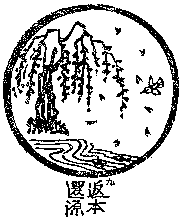
This
stage marks resting in the full recognition of the Source as ‘consciousness
without an object’. It can be understood as the complete penetration of Ramana Maharshi’s
ultimate koan, 'Who am I?' It is the
return to the center from which all thoughts and the entire universe arises: pure Consciousness
itself, self-radiant without cause or object, unqualified and perfect. Things are as they are: the ‘river flows
tranquilly on and the flowers are red’. Nothing is the same because now our eyes are open. And yet nothing has changed -- the entire universe remains as it has always been. The river flows and the flowers are red. We had to seek truth to realize that there is nothing to seek: the very reality that we are immersed in is the truth, and we are that reality.
10. In the World (Entering the Marketplace with Helping Hands)
Barefooted and naked of breast, I mingle with the people of the world. My
clothes are ragged and dust-laden, and I am ever blissful. I use no magic to
extend my life; now, before me, the dead trees become alive.

In some of the parables of the tenth stage, the seeker (now a finder) re-enters the world with a gourd, traditionally used for holding wine. The wine can be seen as symbolic of the true sage’s embrace of life and willingness to share their enlightenment with society and the world. It is an echo of an old idea found in many wisdom traditions that any deep spiritual realization must ultimately be shared in some way with the world for it to have lasting value and meaning.
The 10th stage also speaks to the tradition of the 'crazy-wise' teachers, who seek to utilize any means to awaken others—even by entering into, and participating in, their ‘reality-tunnels’ or private dream-worlds. According to Mahayana Buddhist teachings a true ‘crazy wisdom master’ is only one who has reached a profound level of awakening and has been purified of character defilement. This enables them to enter into any dimension of reality without concern of becoming tainted and thereby having their clarity, or motives, for helping others compromised.
Copyright 2011 by P.T. Mistlberger